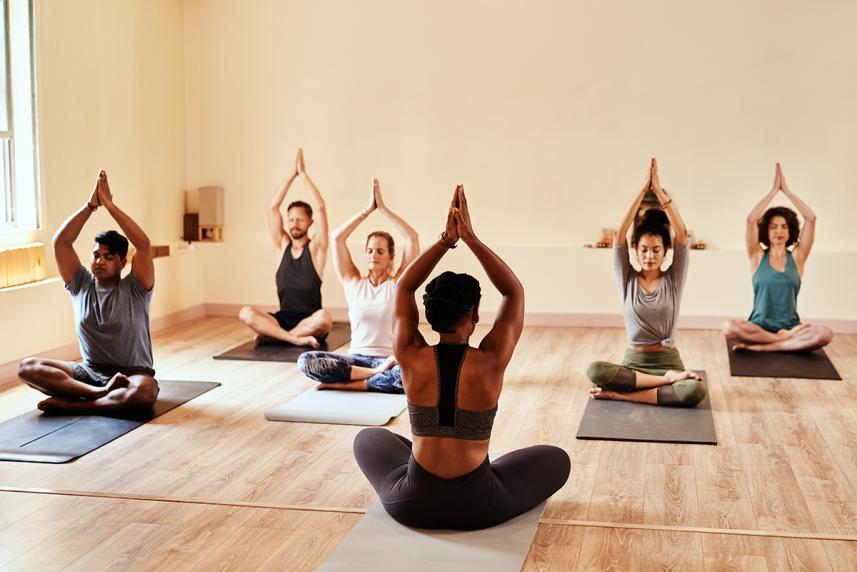3 popular fitness classes, explained
Here’s what to expect before you sign up

1. WATER AEROBICS
Gone are the days of flowered swim caps and show tunes. Now, aquatic exercise goes beyond synchronized swimming, and it’s making a comeback. “Just about any class format you can imagine done on land can be done in the pool,” says Julie See, president of the Aquatic Exercise Association and a Nokomis, Florida-based aquatic exercise instructor. See currently teaches Tabata, a form of high intensity interval training (or HIIT). See loves its simplicity and efficiency. “It’s one move repeated, and it’s also self-paced. I have ages up to 75, and they love it too. Young and old, fit, not fit, it can be a challenging, fun, self-paced workout.”
Why it works: Muscles face more resistance in water than on land. Water is also easier on knees and ankles as you aren’t hitting the ground as hard. Water workouts can help you balance. “Because the water surrounds you, it gives you support,” See says.
Before you go: For classes in the shallow end, water shoes are a must to protect your feet and prevent slipping.
Pro tips: Find the right depth for your body, See says. “For most people in shallow water, you want the water in the middle of the rib cage to the chest so that when you’re doing the movement, you can keep your feet on the bottom of the pool without floating away.” Stand tall with your core muscles engaged, and be sure to land on the balls of your feet, pressing through to your heel, when doing any jumping moves.
2. YOGA
Vinyasa, Bikram, Hatha, or Kundalini—so many schools of yoga, and so many ways to find a style that’s right for you. “There is nothing I enjoy more than the creative movement, being challenged, complete concentration, and knowing that all of this results in innumerable health benefits,” says Julie Wilcox, creator of the Julie Wilcox Method (JWM) and a New York City-based certified yoga teacher.
Why it works: Yoga practice fosters a mind-body connection and allows you to access various muscle groups (some of which you may not realize you had!). “Every routine is made of individual moves that require technical mastery,” Wilcox says. Yoga creates awareness of the body and its habits. Many exercises help us break out of “going through the motions,” such as always crossing the right leg over left while sitting cross-legged. Your teacher may ask that you switch sides.
Before you go: Do research in advance to help you understand what to expect from a particular studio, gym, or teacher, Wilcox suggests. Ask around or use online resources so you can arrive to class feeling comfortable.
Pro tips: Pay close attention to the components of each sequence and instructor’s directions, Wilcox says. Before class, let your teacher know if you are a beginner or have special concerns. You may also want to review basic yoga moves. Most importantly: “Take your time and work at your own pace.”
3. BARRE
Barre class is not just for ballet-bred Tchaikovsky listeners. A new trend in barre is “Core Fusion,” which was created by trainers Fred DeVito and Elisabeth Halfpapp of Exhale Spa in New York City. The core fusion model combines ballet sequences and intense cardio intervals. Or, you can stick to standard barre. Halfpapp most enjoys: “The long lean muscles that are a result of the barre class plus superb alignment and posture!”
Why it works: Doing barre, your priority is to work on position and alignment before focusing on repetitions, Halfpapp says. That way, there is force and precision behind each repeated move. During class, students are encouraged to clear the mind and focus on breathing, she says. “Listen to the teachers cues, and react to those cues without over thinking them.”
Before you go: Set a 10-class goal for best results, Halfpapp recommends. “Your muscles will be sore [after class], so come back as soon as possible (the next day or following) to take care of this soreness.”
Pro tips: A chain is only as strong as its weakest link, Halfpapp says. “Check your ego at the door, stay humble, be ready to work on areas of your body and exercises that you need. These may not be the exercises that you necessarily love or are good at doing.” But that’s all part of the fun.
Talk to your doctor before beginning any new exercise program.


